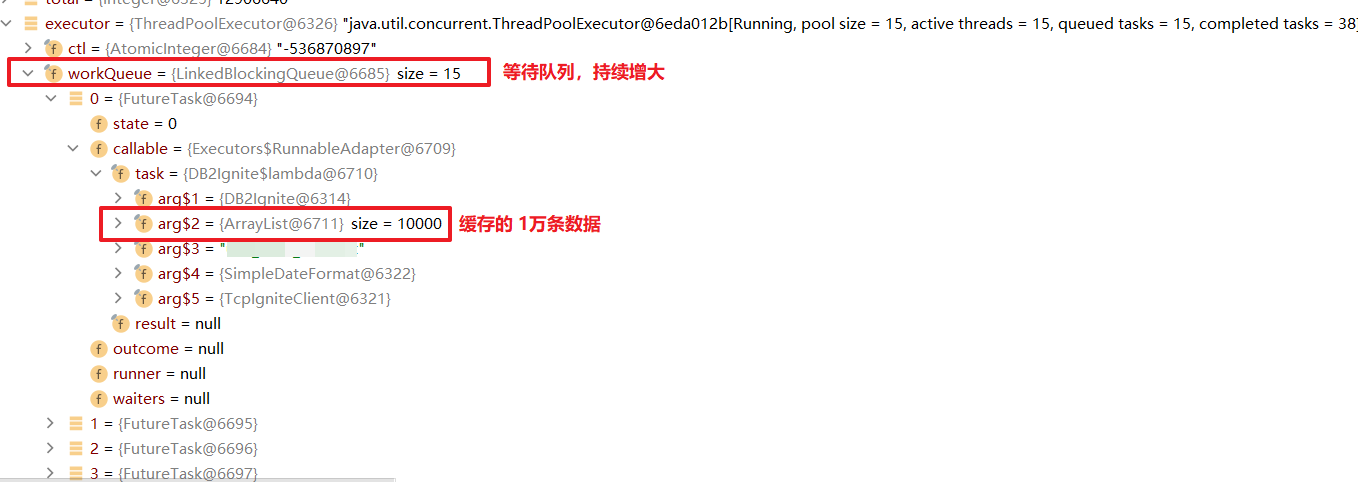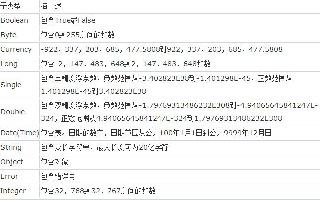Java多線程導致CPU占用100%解決及線程池正確關閉方式
情景:1000萬表數(shù)據(jù)導入內(nèi)存數(shù)據(jù)庫,按分頁大小10000查詢,多線程,15條線程跑。使用了ExecutorService executor = Executors.newFixedThreadPool(15)本地跑了一段時間后,發(fā)現(xiàn)電腦CPU逐漸升高,最后CPU占用100%卡死,內(nèi)存使用也高達80%。
排查問題Debug 發(fā)現(xiàn)雖然創(chuàng)建了定長15的線程池,但是因為數(shù)據(jù)量大,在For中循環(huán)分頁查詢的List會持續(xù)加入LinkedBlockingQueue()隊列中每一個等待的任務,又加載了1萬的數(shù)據(jù)。所以不管是線程數(shù)的CPU搶占,還是內(nèi)存的消耗都是極高。所以是不是能夠控制等待隊列LinkedBlockingQueue的上限就可以了。

使用AtomicLong 統(tǒng)計線程是否完成,再執(zhí)行executor.submit()提交新的任務導隊列中。偽代碼如下:
private AtomicLong threadNum = new AtomicLong(0);public void init() throws Exception {ExecutorService executor = Executors.newFixedThreadPool(15);Integer total = accountMapper.selectCount(new QueryWrapper<>());Integer pageSize = 10000; // 頁大小Integer pageCount = (total + pageSize -1) / pageSize; // 總頁數(shù)for (Integer start = 1; start <= pageCount; start++) {List<Account> list = accountMapper.selectPage(new Page<>(start, pageSize), query).getRecords();//等待線程任務完成,設置30,可令運行線程數(shù)為15,等待隊列線程數(shù)為15while (threadNum.get() >= 30){Thread.sleep(5000);}//開啟1個線程+1threadNum.incrementAndGet();executor.submit(() -> {try {// 處理業(yè)務dealMessage(list);// 任務完成 -1threadNum.decrementAndGet();} catch (Exception e) {e.printStackTrace();}});}executor.shutdown();executor.awaitTermination(1, TimeUnit.DAYS);}
效果就是CPU保持在15~45%之間,內(nèi)存占用也只有45%。
目前只想到這樣的方式,控制等待隊列LinkedBlockingQueue的上限,還有更好的方式請告知,感謝!
2021-02-03-分割線最近又用到了多線程開發(fā),發(fā)現(xiàn)了還是有很多方式控制的。簡單的使用java的Semaphore令牌限流控制也能實現(xiàn)。
多線程: 線程池必須關閉,main主線程才能結(jié)束(接口才會返回)finally { executorService.shutdown(); } 主線程等待保證多線程所有子線程任務執(zhí)行完畢,再結(jié)束。 -> executorService.awaitTermination(1, TimeUnit.DAYS); semaphore 令牌限流控制fixedThread線程池,本例子就是最多同時擁有2個線程進行工作 fixedThread.execute() fixedThread.submit() 的差別除了后者可以返回結(jié)果外,后者還會catch掉異常信息,無法拋到主線程中。public static void main(String[] args) { final List<String> tableNames = new ArrayList<>(); tableNames.add('a'); tableNames.add('b'); tableNames.add('c'); tableNames.add('d'); tableNames.add('e'); tableNames.add('f'); final Semaphore semaphore = new Semaphore(2); final ExecutorService fixedThread = Executors.newCachedThreadPool(); for (final String tableName : tableNames) {//阻塞,獲取令牌try { semaphore.acquire();} catch (InterruptedException e) { e.printStackTrace();}//dofixedThread.execute(() -> { //can throw ex log final ExecutorService executorService = Executors.newCachedThreadPool(); try {executorService.submit(() -> { //can’t throw ex log //int i = 1/0; System.out.println('tableName2:' + tableName);});//int i = 1/0;System.out.println('tableName:' + tableName); } catch (Exception e) {e.printStackTrace(); } finally {executorService.shutdown();try { executorService.awaitTermination(1, TimeUnit.DAYS);} catch (InterruptedException e) { e.printStackTrace();}semaphore.release();System.out.println('semaphore.release'); }}); } // 記得關閉線程池 fixedThread.shutdown(); try {fixedThread.awaitTermination(1, TimeUnit.DAYS); } catch (InterruptedException e) {e.printStackTrace(); } System.out.println('主線程...');}
打印結(jié)果
tableName:btableName2:btableName:atableName2:asemaphore.releasesemaphore.releasetableName:dtableName2:dtableName:csemaphore.releasetableName:etableName2:csemaphore.releasetableName:ftableName2:esemaphore.releasetableName2:fsemaphore.release主線程...
到此這篇關于Java多線程導致CPU占用100%解決及線程池正確關閉方式的文章就介紹到這了,更多相關Java多線程CPU占用100%內(nèi)容請搜索好吧啦網(wǎng)以前的文章或繼續(xù)瀏覽下面的相關文章希望大家以后多多支持好吧啦網(wǎng)!
相關文章:
1. ASP基礎知識VBScript基本元素講解2. Python requests庫參數(shù)提交的注意事項總結(jié)3. IntelliJ IDEA導入jar包的方法4. ajax請求添加自定義header參數(shù)代碼5. 使用Python和百度語音識別生成視頻字幕的實現(xiàn)6. 詳談ajax返回數(shù)據(jù)成功 卻進入error的方法7. Kotlin + Flow 實現(xiàn)Android 應用初始化任務啟動庫8. 使用python 計算百分位數(shù)實現(xiàn)數(shù)據(jù)分箱代碼9. vue-electron中修改表格內(nèi)容并修改樣式10. python操作mysql、excel、pdf的示例

 網(wǎng)公網(wǎng)安備
網(wǎng)公網(wǎng)安備